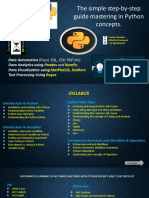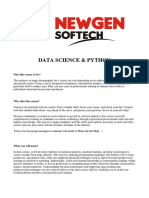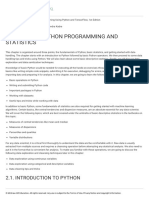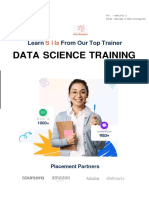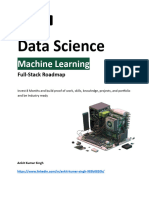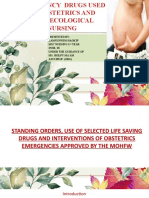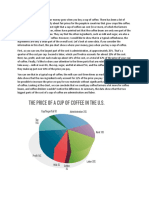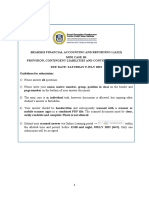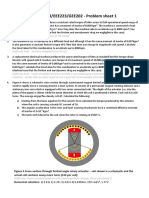PYTHON PROGRAMMING
DATA SCIENCE - PYTHON
Why Python?
For many people, the Python programming language has strong appeal. Since it’s first
Appearance in 1991, Python has become one of the most popular interpreted programming
Languages, along with Perl, Ruby, and others. Python and Ruby have become especially popular
since 2005 or so for building websites using their numerous web frameworks, like Rails (Ruby)
and Django (Python). Among interpreted languages, for various historical and cultural reasons,
Python has developed a large and active scientific computing and data analysis community. For
data analysis and interactive computing and data visualization, Python will inevitably draw com-
parisons with other open source and commercial programming languages and tools in wide use,
such as R, MATLAB, SAS, Stata, and others. In recent years, Python’s improved support for
libraries (such as pandas and scikit-learn) has made it a popular choice for data analysis tasks.
Combined with Python’s overall strength for general-purpose software engineering, it is an
excellent option as a primary Language for building data applications.
What people are increasingly finding is that Python is a suitable language not only for doing
research and prototyping but also for building the production systems. Why maintain two devel-
opment environments when one will suffice? I believe that more and more companies will go
down this path, as there are often significant organizational benefits to having both researchers
and software engineers using the same set of programming tools.
Python Programming Level 1
Contents
Beginning Python
1. Introductions
2. Lexical matters
3 Statements and inspection preliminaries
4 Builtin datatypes
5 Functions and Classes A Preview
6 Statements
7 Functions, Modules, Packages, and Debugging
8 Classes
9 Special Tasks
10 More Python Features and Exercises
Advanced Python
Introduction Python
Regular Expressions
Iterator Objects
Unit Tests
Parsing
GUI Applications
Guidance on Packages and Modules
End Matter
Python Workbook
Introduction
Lexical Structures
Execution Model
Builtin Data Types
Statements
Functions
Object oriented programming and classes
Additional and Advanced Topics
Applications and Recipes
Installation and Setup
Community and Conferences
Level 2-Professional Level - Python for Data Analysis
Contents
Python Language Basics, IPython, and Jupyter Notebooks
The Python Interpreter
Python Language Basics
Built-in Data Structures, Functions, and Files
Data Structures and Sequences
Files and the Operating System
Bytes and Unicode with Files
Conclusion
NumPy Basics: Arrays and Vectorized Computation
The NumPy ndarray: A Multidimensional Array Object
Universal Functions: Fast Element-Wise Array Functions
Array-Oriented Programming with Arrays
File Input and Output with Arrays
Linear Algebra
Pseudorandom Number Generation
Example: Random Walks
Conclusion
Getting Started with pandas
Introduction to pandas Data Structures
Essential Functionality
Summarizing and Computing Descriptive Statistics
Conclusion
Data Loading, Storage, and File Formats
Reading and Writing Data in Text Format
Binary Data Formats
Interacting with Web APIs
Interacting with Databases
Conclusion
Data Cleaning and Preparation
Handling Missing Data
Data Transformation
String Manipulation
Conclusion
Data Wrangling: Join, Combine, and Reshape
Hierarchical Indexing
Combining and Merging Datasets
Reshaping and Pivoting
Conclusion
Data Aggregation and Group Operations
GroupBy Mechanics
Data Aggregation
Apply: General split-apply-combine
Pivot Tables and Cross-Tabulation
Cross-Tabulations: Crosstab
Conclusion
Time Series
Date and Time Data Types and Tools
Time Series Basics
Date Ranges, Frequencies, and Shifting
Time Zone Handling
Periods and Period Arithmetic
Resampling and Frequency Conversion
Moving Window Functions
Conclusion
Advanced pandas
Categorical Data
Advanced GroupBy Use
Techniques for Method Chaining
Conclusion
Introduction to Modeling Libraries in Python
Interfacing Between pandas and Model Code
Creating Model Descriptions with Patsy
Introduction to statsmodels
Introduction to scikit-learn
Continuing Your Education
KHDA (Knowledge & Human Development Authority).
-
ty assurance and regulatory authority of the Govern-
ment of Dubai,
AUTODESK
-
-
tries.
IATA/UFTA Montreal, Canada Extensive training
operators, governments, ground service providers,
travel agents, young professionals and more.
CIPS-UK
Leading global excellence and offering chartered status
in procurement and supply chain.
ACCA (the Ass
tants) Global body for professional accountants. IMA is the
CIMA ; of Management Accoun-
professionals in business. Founded in 1919, IMA is one
tants – World's largest professional body of manage-
ment accountants offering most relevant finance qualifi-
profession
ZABEEL Advantage
With three decades of experience in designing
AIBM
the best training experience, ZABEEL understands the
nuances of training needs that are relevant and in (AIBM) USA -
demand in the market. This makes all the difference
when you choose an experienced training provider like
ZABEEL for an unparalleled training quality and learning
-
outcomes
Management (AIPLM) accredates Purchasing and
DUBAI SHARJAH
Near Burjuman Metro Station Buhaira Corniche










